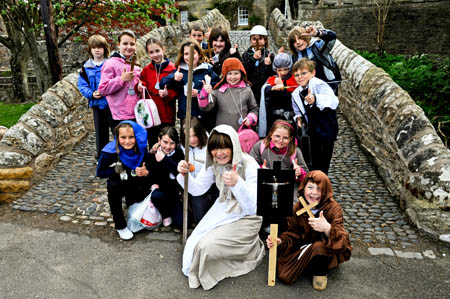
Pupils of Ceres Primary School gather at the village's Bishop's Bridge to receive a pilgrim as she travels along the ancient route to St Andrews. Photo: Marc Marnie
Walkers and cyclists can take a trip back in time with the launch of a website detailing some of Scotland’s historic paths and tracks.
The routes range from smugglers’ trails to military roads; coffin roads to old railway tracks. There are more than 2,000km (1,243 miles) of paths described, and information is backed up by maps of the routes. The Heritage Paths Project has been developed by the Scottish Rights of Way and Access Society – ScotWays for short, and made possible by a Heritage Lottery Fund grant and funding from Scottish Natural Heritage.
Heritage Paths Project officer Neil Ramsay described the online database: “The website includes old paths and roads that were used for a wide variety of purposes,” he said. “These include coffin roads used to take the dead to be buried in consecrated ground; Roman roads built nearly 2,000 years ago and the drove roads that saw hundreds of thousands of cattle walking from all parts of Scotland to descend on the big cattle Trysts at Crieff and Falkirk.”
The website already contains many historic paths, but Mr Ramsay is keen to keep adding to the project. He said: “Ideally the resource should continue to grow and expand as people use it and contribute their own local knowledge and information about the old paths in their areas.
“There are also aspects of paths’ history that are undocumented and we’d like users to see the website as a dynamic resource that can be added to.”
Modern Google Maps are combined with historic Bartholomew maps in a system designed by the National Library of Scotland.
The project brings together carefully researched images, maps and information relating to the traditional routes and long-distance paths used down the generations for journeys such as trade, pilgrimage, travel and burial customs.
The Heritage Paths Project was launched by children from Ceres Primary School in Fife, who walked along the local path The Waterless Road, accompanied by professional school guide Forth Pilgrim who explained its history.
Chairman of ScotWays George Menzies, said: “ScotWays has been protecting and promoting paths for over 150 years and we are delighted to be able to pass on our knowledge of the paths’ histories in such an accessible way.”
Information on the paths is available on the Heritage Paths website.